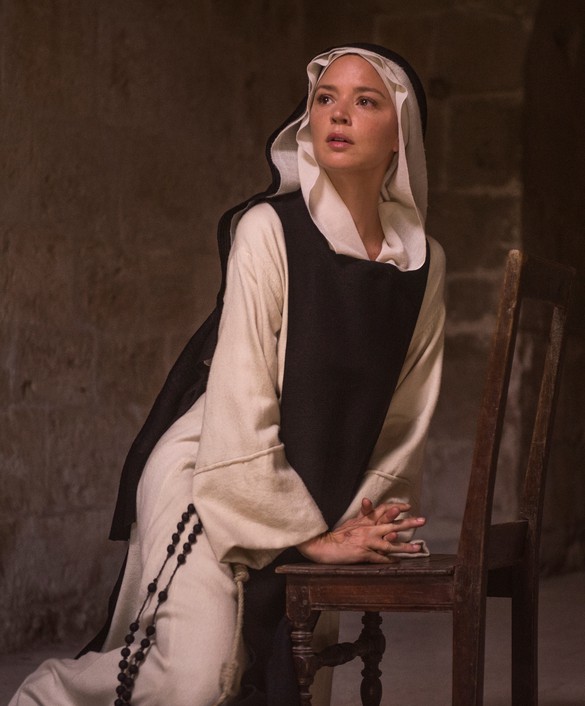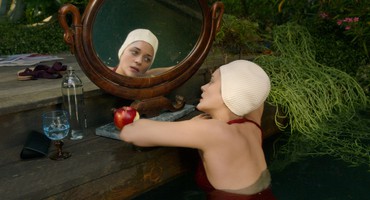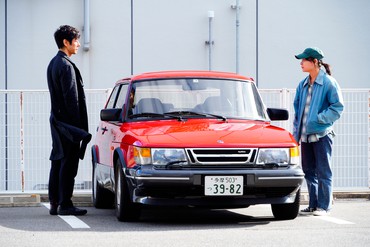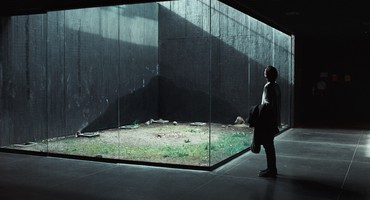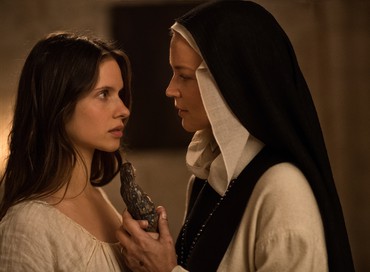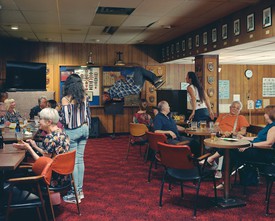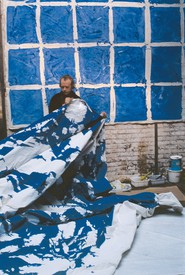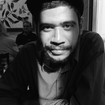
Carlos Valladares is a writer, critic, programmer, journalist, and video essayist from South Central Los Angeles, California. He studied film at Stanford University and began his PhD in History of Art and Film & Media Studies at Yale University in fall 2019. He has written for the San Francisco Chronicle, Film Comment, and the Criterion Collection. Photo: Jerry Schatzberg
I remember everything. So I try to limit what I see. That’s why I never watch movies or TV. There are already too many histories in this world. Like this rock. . . . Experiences are harmful. They leave a violent flurry in my memory.
—Apichatpong Weerasethakul, Memoria, 2021
At the 2021 Cannes Film Festival, indignant European tourists were turned away from the Palais des Festivals et des Congrès before a screening of François Ozon’s Tout s’est bien passé (Everything Went Fine) because their covid tests had expired. They got red in the cheeks and raised hell in three languages, but the bilingual grad-student guards, pretending not to hear, refused to budge.
Later, a young woman was breaking up with her sullen, droopy-eyed boyfriend outside a Cannes disco, her crying fits broken up by the pulse of the dull sounds inside. It was like a slapstick outtake of Éric Rohmer’s Conte d’été (A Summer’s Tale, 1996). She would raise her voice over the din to explain why he was a prick, but the club door kept swinging open and her diatribe kept getting swallowed, so she constantly had to repeat what she had just said. He looked bored to be just standing there, feigning attention, being berated, existing.
The overriding sensation at Cannes was akin to these scenes: a film industry and its confused audience in crisis, caught in the frantic grips of a transition that no one important was prepared to tackle. Many of the films shown were first stutters toward grappling with the pandemic and with the latest mutations of capitalism it had produced. But the beaches were open; the water, gorgeous; skinny-dipping college students, floppy-necked dads and their loud children, and Parisian heiresses were in abundance. There was a good amount of high-prestige dreck, of course, but there were also films that went beyond topicality and an insular politics. Here are five festival debuts that shattered through the herd, beacons for burgeoning filmmakers and cinema lovers alike.
ANNETTE
Those who go to movies for digestible stories, lessons, or moral uplift will be sorely disappointed, hopefully even left furious, by Leos Carax’s Annette. It is not the kind of movie that encourages disciples; its sobering, savage clarity can only be handled in select doses. To make an emotionally unpleasant musical on Amazon’s dime, then to make only one or two songs genuine earworms (and repetitive ones at that)—the rest of the score cold Brechtian Sprechgesang—is a daft coup on the part not only of Carax but also of Ron and Russell Mael, the duo behind the weirdo-electro ’70s pop band Sparks, who composed the score for the film (their first).
Adam Driver plays Henry McHenry, aka the Ape of God, a “mildly offensive” stand-up comic in the Lenny Bruce tradition. Amazingly, he can still shock the excitable gentrifiers of Silver Lake, Los Angeles, with his green bathrobes, his bananas that double as ashtrays, and his cataclysmically unfunny, nasty spasms of rage: “Trying to be funny here is like trying to enjoy a blow-job in a gas chamber.” Later: “Oh dear public, you fuckin’ headless beasts! You make me sick—you ruthless, unpredictable beasts!” An egomaniacal monster whom you want toppled and smashed, Driver’s Henry prowls in long-take tableaux as he wavers in and out of sing-songy screeches, howling in desperation and a too-intense rage at the audience that catapulted him to fame: “Yes, yes, yes, laugh, laugh, laugh. What’s your fucking problem?” Henry dates Ann (Marion Cotillard), a doe-eyed soprano with a sweet demeanor and a redhead pixie cut à la Jean Seberg. They shock the press and their intimates: “What does she see in him?” To save the relationship, they conceive a child, Baby Annette: a petit guignol played by a literal puppet. After a series of tragedies that must be seen to be believed, Henry and Ann’s relationship sinks, and under the tutelage of an increasingly psychotic Driver, their puppet baby becomes a global superstar.
The Los Angeles of Annette is filled with daily horrors. Uncontrollable yearly wildfires and serial male abusers are a regular fact in its expressionist sprawl. In Carax’s LA, forests still grow gnarly, Grimm-like branches beneath which lovers can glacially trudge, like the fairy-tale people in F. W. Murnau’s Sunrise (1927). But this is also a city of enchanting dream textures, reminiscent of the LA of Jacques Demy’s Model Shop (1969). One throwaway shot of the cityscape jams together the pointillists, the noir writers, and Paul Leni: a foregrounded fern at night blows at the head of a sea of red-blue-green electric lights, which, by way of a delicious rack focus, blur into a formless splotch. Carax thanks Edgar Allan Poe in the credits, which made me wonder whether he was aiming for his own entry in that long heritage of the grotesque that has gripped the romantic imagination of French modernists going back to Baudelaire. If so, he aimed well.
Driver’s performance oscillates between two irreconcilable animals: a sulking orangutan (beefy arms swinging in abandon during fits of rage, a desire to smother his intimates’ attention through a fatherly loathe-love) and a sedate zoo-leopard (cute, regal, and inexplicably detached and dissociated from every outrageous situation, whether a rave with hot Euro girls, a prison cell, or the morbidly green swimming pool where he drowns an opera conductor). Like the movie through which he drags his feet and beats his chest, Driver’s Henry McHenry is incoherent to the max. When two of the film’s protagonists drown because of him, he can only respond in half-drunken slurs: “There’s so little I can do . . . ” Responsibility for the crimes is diverted. Driver’s body becomes the site upon which movie star beauty unspools and is canceled by its morbid, sputtering underbellies: voyeurism, possession, an inflated sense of self-worth based on idealized images that bear no relation to the real.
Beyond its unabashed weirdness, Annette is blatant about the process by which parents mold their children into extensions of themselves to be adulated and loved by a network of fans. Henry turns Annette into a pop-star spectacle for most of her puppet life. But once she grows up—though still a child, played in the film’s final scene by five-year-old Devyn McDowell, who ranks with Beatrice Straight in Network (1976) and Penelope Allen in Scarecrow (1973) in terms of walk-on roles that establish a movie’s emotional core—Annette, in a sudden, five-minute burst of fury, begins to doubt everything she’s been taught. No longer a puppet but flesh and blood, she begins the long, tragic process that takes up most of our adult lives: killing the masters that formed us.
When people, especially Americans, hear the word “musical,” they usually expect “upbeat.” “Pretty.” “Clean.” “Virtuosic.” Carax and Sparks reject these expectations. It takes gumption to make an object like this that will only appeal to perverts, broken-hearted loners in big cities, morbid romantics who obsessively rewatch Nick Ray’s On Dangerous Ground (1951), and people whose ideas of a flirty Friday night is curdled pop Brecht. That’s not many. But the freaks are loud. They adore Carax’s curiously disengaged camera, whose only trick up its sleeve is a bombastic 360-degree twirl around the dude from Big Bang Theory. One such freak: a twenty-three-year-old Ukranian bloke I met on the Croisette on the last day of the festival. He said he was passing through the city for a couple of days but managed to snag a free ticket to Annette. He was so visibly fired from it I thought his throbbing blood vessel was going to burst. He says it will revolutionize the genre of musicals. He wants to make musicals. I wish souls like his all the mad best; the future is theirs.
DRIVE MY CAR
My favorite film at Cannes is the latest from one of the most profound and sensitive directors working today, Ryusuke Hamaguchi. Drive My Car, which won the Best Screenplay award, qualifies as Hamaguchi’s most moving, finely tuned work to date. It is an unconventional melodrama that, like the Chekhov plays that are woven into the movie’s plot, preserves the mystery of human experience with elegance and anguish. More than in any previous Hamaguchi film (he has also made the major works Asako I and II of 2018 and Happy Hour of 2015), the palette of emotions expands dramatically as the filmmaker and his actors face the voids of quiet lives endured in the shadow of loss.
The three-hour Drive My Car (it earns every single minute of its runtime) is a loose riff on the 2015 Haruki Murakami short story of the same name, the lead story in his collection Men Without Women. Kafuku (Hidetoshi Nishijima) is an actor, director, and widower putting together a theatrical adaptation of Chekhov’s Uncle Vanya (1898), whose title role he has played dozens of times to great acclaim. One of the clever conceits of Kafuku’s Vanya is that he purposely casts actors who speak different languages and encourages them to speak in whatever language they prefer: Mandarin Chinese, English, Japanese, even Korean sign language. But when Kafuku gets into a car accident that slightly damages his eyes, the theater company hires Misaki, a young driver played with brilliant understatement by Toko Miura, to drive him around Hiroshima. Soon, driver and director begin to open up to each other about their buried pasts. Like Murakami’s story, most of the film is confined to these conversations inside the car and the vivid recollections they evoke: of Misaki and her abusive parents; the sudden passing of Kafuku’s wife, Oto (Reika Kirishima), a screenwriter, and the early death of their daughter; the affairs Oto carried out discreetly. As the narrative unfolds, the lives of the characters play out within a theater of unrepresented, vivid memories—unreliable yet open to revision.
For the critic James Lattimer, “heralding Hamaguchi as the future of cinema might be premature.”1 Without playing this tiresome game of Predictions—hailing the most Radical or Out There—we can say that Hamaguchi offers one path forward into yet-unforged cinematic grace. One need not be a card-carrying revolutionary like Chantal Akerman, Abbas Kiarostami, or Jacques Rivette; one can also choose to follow Hamaguchi, whose termitelike studies of women and their battles with chance and destiny reach a grave apotheosis with Drive My Car. He and his screenwriter, Takamasa Oe, have extended a twenty-page short story into a devastating 180-minute adagio of longing, absence, performance, and communication breakdown. To watch Drive My Car is to slowly come to terms with life as little more than ghosts, transferences, gaps, and silences.
In a discussion of psychoanalysis, Janet Malcolm had perfect words for what Kafuku’s actors enact in their strange multilingual Uncle Vanya: “Even (or especially) romantic love is fundamentally solitary, and has at its core a profound impersonality. The concept of transference at once destroys faith in personal relations and explains why they are tragic: We cannot know each other. We must grope around for each other through a dense thicket of absent others. We cannot see each other plain. A horrible kind of predestination hovers over each new attachment we form.”2 The most anguished moment in recent cinema is exactly such a moment of transference, where Misaki leans in gently, with quick-thinking moral professionalism, into Kafuku’s arms and, in an effort to stop his choked stream of tears, hugs him tightly, letting him pretend that her body is the body of everyone he’s loved and lost in his life.3 Whom she herself might be thinking of we never learn. After three hours of observation, we don’t expect any such outburst from these coiled characters, but when it comes, the salon is hushed, gutted. With this moment, and with all the unconventionally shot conversations that form the core of Hamaguchi’s neo-Rohmerian talkies, Malcolm’s theory is given concrete form. Who better to accomplish this task than Hamaguchi, a voracious cinephile who has his feet in all the films he’s seen, the rest of himself in the substance of life we barely pay attention to as the real.
To fumble with the nuances of this film on paper is almost to destroy its delicate, surging sadness. It’s better to recall fragments and lines that stick with you:
1. Misaki and Kafuku visit a Hiroshima waste factory where pieces of garbage are burned into tiny white strips that look like shredded diary pages. “Isn’t it a bit like snow?” she asks, to no response.
2. “The foreign language parts put me to sleep.”
3. “She betrayed me so naturally when she loved me.”
4. “I wanted to learn her language. So I learned it.” The speech in question: Korean sign language.
5. “People not understanding my words is normal to me. But I can see, I can hear. Sometimes I can understand a lot more than words. That’s what matters most in rehearsal, no? Right now, each day brings so much fun. Chekhov’s text: it moves my body, which seemed stuck before.”
6. Kafuku has his cast repeat their lines over and over until the rhythm is right. Meanwhile, he rehearses his iconic role—Uncle Vanya—by listening and responding to an audiotape that his screenwriter wife, Oto, made for him to help him memorize lines while driving. She plays all the characters in the play, he responds when it’s Vanya’s turn. No gaps. It’s perfect. He keeps using her tape long after she leaves the film as suddenly as Janet Leigh evacuates Psycho, with all of the horror kept underneath the table.
7. “Chekhov is terrifying. When you say his lines, it drags out the real you.”
8. “When you speak to me of love and romance, I’m in a daze. And don’t know what to say.”
9. “Those who survive keep thinking about the dead.”
10. “Respond to the text. It’s questioning you.”
MEMORIA
As Michelangelo Antonioni’s Blow-Up (1966) was for the 1960s, Apichatpong Weerasethakul’s Memoria will be for the 2020s: a profound visual and sonic challenge to empirical knowledge. An alternative title could have been Tilda and Joey Go Boating.4 In other words, Weerasethakul’s latest film is a Rivettean odyssey into the nature of dreams under the thumb of colonialism.
It has something to do with a flower-selling English insomniac named Jessica Holland (Tilda Swinton) who is kept awake by a recurring booming noise, source unknown. We wait with the insomniac as she waits for news of her sick sister in Colombia. And we see the insomniac visit various professionals—a sound engineer, a doctor, a fisherman who may or may not be a ghost from some forgotten ancient-Colombian past—in order to find answers for the incessant booming.
For most of Memoria, Weerasethakul chooses to confuse the lines between waking and dreaming, central plot and marginal detail, life and death—even as, simultaneously, he sharpens the viewers’ sense of their own bodies, their limitations. With each new film, he has inched farther and farther from the structures of both Hollywood entertainment and safer arthouse fare such as Emmanuel Carrère’s Between Two Worlds (2020; the opening film of Cannes’s Director’s Fortnight), or the hits of Todd Haynes and Wes Anderson. With Memoria we get only poetic grace notes that are closer to dreaming: a midnight sextet of car alarms that lull a Latin American city in and out of restless sleep, like an inverted Love Me Tonight (1932); traces of Colombian and jazz symphonies; and the banging thuds from another dimension that haunt Swinton throughout the picture. Weerasethakul even inserts “sleep breaks” into the film; we see people sleeping on-screen, allowing us viewers to doze off too (we’re near Andy Warhol territory). We nap for a few moments, entering a state of both heightened attention and relaxed imagination that is simply gorgeous to experience.
This film of and for the Global South does what Glauber Rocha’s Black God, White Devil (1964) once did at Cannes: it joins a strange, tough, fresh way of looking with hitherto unimagined waves of mystic wonder. Weerasethakul and Swinton invite us to dream visions, unfinished films, and histories of intense surreality—that is to say, realities more real than what we think is real. We submit to the hypnotic flow of this collective dream, which keeps adding stranger and stranger layers with each new scene, evading rational summation. This dream, these memories of a strange landscape not at all ours, continues long after the credits have rolled. What else can you ask of a masterpiece that seems imported from another world yet looks disturbingly similar to ours?
BENEDETTA
No one does sleaze with quite the casual berserk fury of Paul Verhoeven, who proves with Benedetta that the sublime and sacred go hand in hand with the heretical and profane. This lesbian-nun melodrama is peopled with oddballs left over from the musicals of Ken Russell, the allegories of Paolo Pasolini, the wet dreams of Luis Buñuel, all lovers of feverishly religious kinkfests that the Church wouldn’t touch with a ten-foot cross. An audacious holy moment: the titular nun, who might be the resurrected Jesus (Virginie Efira), is praying to a statue of the Virgin Mary, its left tit unfrocked, when the statue topples from the pedestal and pins her to the floor. From the bottom, she kisses the cheap-painted nipple of her holy top, caressing the Virgin’s sides.
Benedetta is based on the uproar that occurred when one Sister Benedetta Carlini started a relationship with another nun, Sister Bartolemea, in a convent in seventeenth-century Pescia. As the relationship deepens, it emerges that Benedetta may be the second coming of Christ—which upsets the hierarchy of power on top of which lies the steely, battle-ready Mother Superior (an excellent Charlotte Rampling). What’s historically accurate and what’s not is largely a moot question; Benedetta is more interested in poking holes (with Sister Benedetta’s wooden-dildo Jesus, no less) into a puritanical yet money-driven society of the kind that Christ fought at the dawn of the millennium, and that Verhoeven has been expertly skewering from Turkish Delight (1973) into his bonkers Hollywood period (1985–2000). Who cares if Benedetta’s fantasies never consisted of her licking out the stigmata? Or that a plague never wiped out a spiteful town that refused to believe in either a woman or an intersex Christ caught at a funeral parade of roses? If they screened this movie at midnight mass, the time of Revelation would be upon us and everyone would sit up straight through the Sunday sermon.
COW
“A chicken is alone in the world,” Clarice Lispector once wrote.5 The cow goes one step further: it is never alone; it is as cognizant as we are. Therein lies its even more brutal fate.
Loud walkouts and angry complaints galore greeted this wordless, violently unwatchable ninety-minute study of the grim life and death of a cow on an English farm. Andrea Arnold, the director of Fish Tank (2009) and American Honey (2016), pushes people to the edges in order to create a work of such unsentimental steel that when the old, sagging cow with a monstrously enlarged udder is finally mercy-killed with a bullet in the brain in the last reel, the Cannes salon filled with the bitterest applause I’ve ever heard. People hate being reminded of their own mortality—still less, the mortality of cows whose language remains a mystery to us, their butchers.
The cow in question is Luma, according to the farmers, or 504481 as we get to know her via her dangling ear tag. 504481 has to learn how to drink milk from a gorgon of a techno-bottle all by herself. Early in the film, we see 504481 give birth to a calf; then we see the traumatic separation of mother and child. 504481 moos after the calf as the latter is tagged swiftly by a man farmer, then caged in a small crate of her own. Soon after, the new calf is branded; all the while, a woman farmer mothers it, stroking its thrashing legs and cooing “Good girl, good girl” throughout the operation.
Any understanding of an animal in art must inevitably be placed in juxtaposition with the suffering of humans. This is the inherent selfishness of our lives and our art; not even Robert Bresson, who made films of even more distilled purity than Cow, escapes it. Certainly he wouldn’t have conceived of a scene as wildly clichéd as the sex between 504481 and a bull. Here, human standards are grafted onto a moment with the old-fashioned obviousness—and none of the charm—of the fireworks fuck of Cary Grant and Grace Kelly in Alfred Hitchcock’s To Catch a Thief (1955): we’re shown the bull’s penis, 504481’s eyes Want It, fireworks soar over the farm, and we hear the sounds of sexy rub-me-down R&B. All that’s missing is a speech bubble out of a Tex Avery cartoon from the cow’s eyelashes: “Hubba-hubba.” Arnold’s American Honey tendency to water down a radically unexciting scene with topical pop and hip English irony rears its head every now and then, conceding that a viewer exists. Luckily, these interruptions don’t last too long, and she mostly maintains a ghastly flatness to breaking point. Certain passages—some scenes of 504481 passing across wet paddies and mud puddles with maddeningly emotion-clogged expressions on her face—approach the poetic discomfort of Au hasard Balthazar (1966) when Bresson films the donkey, or of Clarice’s story about a hen.
The point, overall, is not to craft a PETA tract—look how we treat animals, stop eating meat, cows are people, too—but rather to paint the pointless suffering that unites creatures who have the capacity to love. Fated to protect and lose, reminded rudely of this fact by Cow, I could only stumble out of the cinema and into remembering Clarice’s wise words about the life of a puny hen:
Not even at these moments did the expression of her empty head change. In flight, at rest, giving birth, or pecking corn—it was the head of a hen, the same that was designed at the beginning of the centuries.
Until one day they killed her and ate her and the years went by.6
1James Lattimer, “Cannes 2021: Tomorrow Now and Then,” The Brooklyn Rail, September 2021. Available online at https://brooklynrail.org/2021/09/film/Cannes-2021-Tomorrow-Now-and-Then (accessed September 25, 2021).
2Janet Malcolm, Psychoanalysis: The Impossible Profession (New York: Vintage Books, 1980), p. 6.
3The moment, and all of Drive My Car, is also worthy of Henry James in morbid-poltergeist mode (his best). See “The Friends of the Friends” in particular.
4“Joe” is Apichatpong Weerasethakul’s nickname; Céline and Julie Go Boating (1974) is Jacques Rivette’s radical 190-minute comedy about a magician and a librarian (Juliet Berto and Dominique Labourier) who meet on the street, become best friends, and discover a mysterious plot (a movie, one could say) unfolding inside a haunted Victorian house down the street from them. Céline and Julie . . . is one of the most wildly sophisticated films about dreams, cinema, friendship, and the boundary-breaking potential of playfulness ever conceived. The film critic David Thomson once told me he considered it “the most innovative narrative film since Citizen Kane.” The Criterion Collection and Janus Films released a restoration of the film on DVD and Blu-Ray in January 2021. Memoria swirls in Rivettian openness and surrealism, constructing a similarly vast allegory about the strange nature of movie-watching and how the viewer can turn from a passive to an active subject.
5Clarice Lispector, “A Tale of So Much Love,” trans. Katrina Dodson, in The Complete Stories of Clarice Lispector, ed. Benjamin Moser (New York: New Directions, 2018), p. 404.
6Clarice Lispector, “A Hen,” trans. Elizabeth Bishop, in Elizabeth Bishop: Poems, Prose, and Letters, ed. Robert Giroux and Lloyd Schwartz (New York: Library of America, 2008), p. 310.
